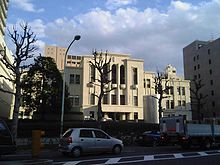Takaki Kanehiro
Baron Takaki Kanehiro ( Jap. 高木兼寛 ; * the thirtieth October 1849 in Mukasa , district Morokata , Hyūga Province (now Miyazaki , Miyazaki Prefecture ); † 13. April 1920 ) was a Japanese naval surgeon and founder of several medical institutions in Japan.
Life
origin
Born in Hyūga Province to a samurai , Takaki studied Chinese medicine and served as a doctor in the Boshin War . He then studied Western, British-influenced medicine with William Willis . Takaki joined the Imperial Japanese Navy as a doctor in 1872 . In 1875 he sat in Great Britain at St Thomas' Hospital in London . In 1880 he returned to Japan. He was in contrast to most of the Japanese doctors of his time, who had studied according to German documents or at German universities.
Combating beriberi
At the time, beriberi was a serious problem in the Japanese navy, especially with ordinary Japanese sailors, not European seamen in a similar position or the Japanese officers. Takaki was known that the disease was not widespread in the West and was mainly found among ordinary seafarers who ate almost exclusively white rice, which, unlike other foods, was available for free.
In 1882 Takaki proposed an experiment on beriberi to the Meiji -Tennō as part of a petition. Beriberi was a major problem on ships at the time, Takaki suspected a cause in the diet , possibly encouraged by James Lind's findings on scurvy . In 1884 two warships were sent on a comparable nine-month voyage across New Zealand to South America and back to Japan. On the ship Tsukuba, the sailors received a mixed diet with meat, fish, barley, rice and beans. On the battleship Ryūjō only white rice was served. Of the 376 crew members of the Ryūjō, 161 fell ill with beriberi and 25 fatally. Only 14 men of the tsukuba fell ill and none died, the 14 had secretly refused some of the extra food. Takaki suspected a lack of nitrogenous food as the cause, in the Japanese navy the board food was adapted accordingly and beriberi was reduced dramatically.
In the Japanese army, however, the German school , represented by Mori Ōgai, was predominant, which interpreted beriberi as an infectious disease. As recently as the Russo-Japanese War in 1905, beriberi killed 27,000 as a result. 47,000 soldiers were killed in action.
Takaki's knowledge came 10 years before Christiaan Eijkman's interpretation of beriberi as a deficiency disease and his discovery of thiamine or vitamin B1 as a missing component. Eijkman received the Nobel Prize in Medicine for this in 1929 .
In the meantime, Takaki was the chief military doctor of the Japanese naval forces. In 1881 he founded a predecessor of today's Tōkyō Jikei-kai Ika Daigaku ( 東京 慈 恵 会 医科大学 , German "Medical Charity University Tokyo") in Tokyo as the first private medical college in Japan and the first medical institution in Japan to carry out autopsies . In addition, founded a hospital for the poor in Tokyo, the Yūshi Kyōritsu Tōkyō Byōin ( 有志 共 立 東京 病院 , Eng . " Collective Volunteer Hospital Tokyo") with a nursing school ( 有志 共 立 東京 病院 看護 婦 教育 所 yūshi kyōritsu tōikuō by ), kyōritsu tōikuō by was the first nursing training center in Japan.
honors and awards
He was raised to the Japanese nobility and mockingly referred to as the "barley baron " ( 麦飯 男爵 , Mugimeshi danshaku ), as he had, among other things , enforced the unpopular but effective preparation of rice and barley in community nutrition to combat beriberi.
In 1892, Takaki was appointed a member of the manor house .
He was posthumously honored by naming the Takaki Promontory peninsula in Antarctica .
literature
- Morris Low: Building a Modern Japan: Science, Technology, and Medicine in the Meiji Era and Beyond. Palgrave Macmillan, 2005, ISBN 1-4039-6832-2 .
- Makoto Matsuda: Kakke o nakushita otoko Takaki Kanehiro den. Kodansha, 1990, ISBN 4-06-204487-0 .
Web links
Individual evidence
- ^ Morris Low Building a Modern Japan: Science, Technology, and Medicine in the Meiji Era and Beyond . Palgrave Macmillan (2005). ISBN 1-4039-6832-2
- ↑ a b c [1] Kanehiro Takaki (1849-1920), by Yoshinobi Itokawa, in Journal of Nutrition 106 (5): 581., 1976
- ↑ A late resumption of the 'German School', an alternative interpretation of beriberi as mold poisoning can be found by the nutrition journalist Udo Pollmer as well as Ramsay Tainsh, most recently in Beriberi and Mycotoxicosis: An historical account, by Ramsay Tainsh, International Journal of Environmental Studies, Volume 19 , Issue 3 & 4 September 1982, pages 205-207, but this contradicts the medical literature on the subject
- ↑ Hawk A: The great disease enemy, Kak'ke (beriberi) and the Imperial Japanese Army . In: Mil Med . 171, No. 4, 2006, pp. 333-9. PMID 16673750 .
- ↑ Kanehiro Takaki. In: Prominent People of Minato City. City of Minato, accessed December 2, 2008 .
| personal data | |
|---|---|
| SURNAME | Takaki Kanehiro |
| ALTERNATIVE NAMES | 高木 兼 寛 (Japanese) |
| BRIEF DESCRIPTION | Japanese ship doctor |
| DATE OF BIRTH | October 30, 1849 |
| PLACE OF BIRTH | Mukasa (Miyazaki) , Morokata-gun , Hyūga Province , Japan |
| DATE OF DEATH | April 13, 1920 |

